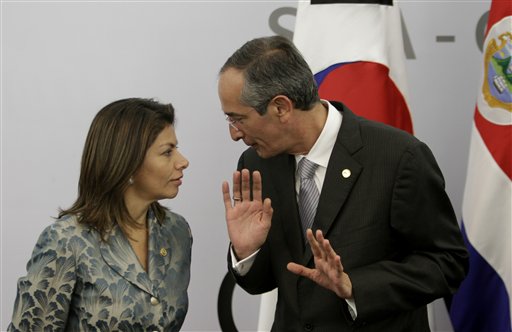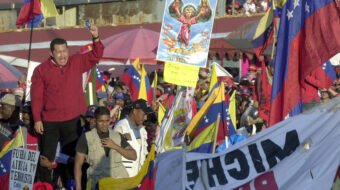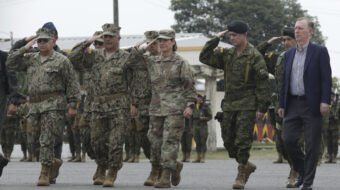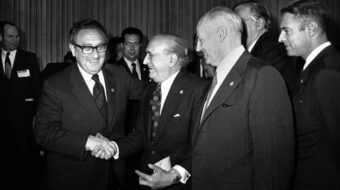
The political opposition in the Central American country of Costa Rica is raising questions about an announced agreement that would allow 7,000 U.S. troops to operate on Costa Rican soil, coordinated with 46 U.S. ships in territorial waters.
Costa Rica is often praised in corporate media for having abolished its armed forces in 1948 and turning the resources thus liberated to better use in maintaining a social safety net superior to that of nearby countries. The truth is a little more complicated.
During World War II, the then-existing international association of communist parties (known as the Comintern) had urged member parties in Latin America and elsewhere to enter into coalitions with all sorts of governments in power, as long as the latter would commit to supporting the worldwide effort against Nazi Germany. This led to a number of “strange bedfellows” situations. So, for example, pre-Castro Cuban communists worked in coalition with the later dictator Fulgencio Batista. The Communist Party in Costa Rica, then called the Popular Vanguard (Vanguardia Popular), cooperated with Costa Rican President Rafael Angel Calderon and his immediate successor, Teodoro Picado, both of the National Republican Party. Out of this alliance came legislation which greatly improved labor rights and social welfare for poor Costa Ricans.
However, the conservative opposition questioned the legitimacy of Picado’s election in 1944, and organized a business shutdown, which in turn led to street disturbances. The 1948 presidential elections, in which ex president Calderon tried to get back into office, were also fraught with problems. When the Congress intervened and declared victory for Calderon, a businessman by the name of Jose “Pepe” Figueres launched an armed uprising and, with U.S. and Guatemalan support, overthrew Picado (who was himself supported by dictator Somoza of Nicaragua).
The abolition of the armed forces by Figueres in 1948 probably had something to do with the fact that there were many communists in the officer corps and the ranks (Figueres also banned the Popular Vanguard Party). Though Figueres, in his three terms as president of Costa Rica, continued progressive social reforms started under Calderon and was publicly critical of U.S. support for the more brutal dictatorships in Latin America, he also did not shrink from working with the CIA and taking the “Agency’s” money when it suited him. So Costa Rica has developed into a relatively prosperous country with a better-than-average social safety net for the region, but with a foreign policy that has tended to be subordinate to U.S. interests.
Figueres’ ideological successors, former President Oscar Arias and current President Laura Chinchilla, are mistrusted by most of the Latin American left. The role played by Arias in the aftermath of the June 28, 2009, coup which overthrew Honduran president Manuel Zelaya greatly heightened existing suspicions. Arias was seen as working in tandem with U.S. Secretary of State Hillary Clinton to deflate regional and international pressure on the coup regime so that Zelaya would not be returned to power. Chinchilla, from Figueres’ and Arias’ own National Liberation Party, was elected earlier this year, defeating both left and right-wing challengers. Though her party is a member of the Socialist International, her views on some issues, such as reproductive rights, are decidedly conservative.
So when Chinchilla’s supporters in Congress approved the plan for 7,000 U.S. Marines and 46 warships to come into Costa Rican land, airspace and coastal waters on an anti-drug, anti-crime and “humanitarian” mission which, moreover, would be suddenly over on Dec. 31 of this year, alarm bells automatically started ringing, both within Costa Rica and regionally. The U.S. embassy in Costa Rica’s capital, San Jose, downplayed the importance of the pact, pointing out that similar ones had been signed in past years, but failed to note that in the past there was no question of so many U.S. troops within a country that does not even have its own army. While it is indeed the case that geography condemns Costa Rica to be a preferred route for drug traffickers moving their wares from South America to the United States, opposition parties and leaders accused the government of compromising Costa Rica’s national sovereignty. Luis Fishman, formerly the presidential candidate of the United Social Christian Party (PSUC) has filed a suit questioning the constitutionality of the presence of the U.S. forces, but it is not known whether or when the Costa Rican Supreme Court will rule on this.
The left-wing, socialist-oriented Frente Amplio (Broad Front) party raised the issue of possible threats to neighboring left and left-center governments such as the ones in Nicaragua and Venezuela.
Regionally, the issue of U.S. troops in Costa Rica now joins that of the seven U.S. bases in Colombia as a bone of contention between the United States on the one hand, and left and left-center governments on the other.
Photo: Costa Rica’s President Laura Chinchilla, left, and Guatemala’s President Alvaro Colom talk in June at the Central America Integration System, SICA, summit in Panama City. (AP/Arnulfo Franco)












Comments